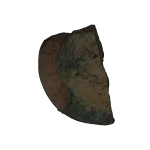
Eaves Tile
Location Karakorum
Dating 13th-14th cent.
Epoch Mongolian empire
Material Building ceramics
Technique Burnt
Description
This fragment of an eaves tile is one of many that were found during the excavations at the “Great Hall”, the Buddhist temple. They provide clear evidence of the strong Chinese influence on the architecture and the presence of Chinese craftsmen. It is known from written sources that Chinese craftsmen played a major role in the construction and expansion of Karakorum. Their traces have been repeatedly found during excavations in Karakorum, for example in the form of Chinese mantou kilns.
Two types of roof tiles can be distinguished, which were laid in alternating rows. Both types ended with a decoration along the eaves. The row at the top ended with a circular, model-shaped decorative plate (瓦當 Wǎdǎng, literally front tile), known in classical archaeology as an “antefix”. The bricks lying on the eaves of the lower bricks extended downwards in a wavy shape and were decorated with punctures of a stamp as well as grooves and incisions (花邊瓦 huābiānwǎ, literally “flower border bricks”). The alternation of round end panels and wavy decoration hanging downwards created the visual effect of a garland running along the eaves. This decorative form is still common on temples and other important buildings in East Asia today.
3D Visualisation
3D Model: H. Rohland
Images: H. Rohland
Literature
Guo, Qinghua. „Tile and Brick Making in China: a Study of the ‚Yingzao Fashi‘“. Construction History 16 (2000): 3–11.
Guo, Qinghua. A visual dictionary of Chinese architecture. Mulgrave, Vic.: Images Pub, 2002.


